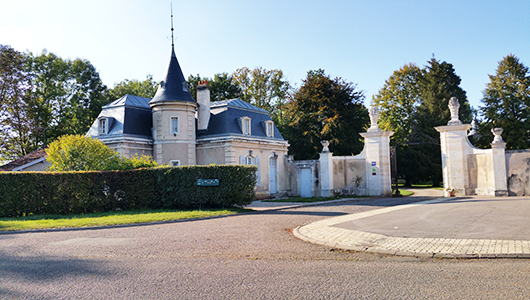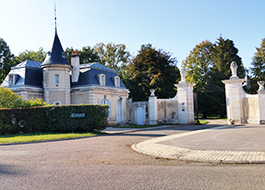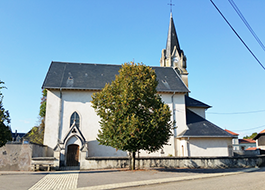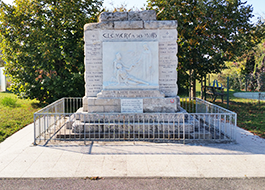Clémery
Durée visite : 40 minutes
Moyen : Pédestre
Un personnage pittoresque est attaché à cette commune. Michel Collin est un religieux français qui s’est autoproclamé pape sous le nom de Clément XV. Il est né à Béchy, en 1905 . Il est décédé à Clémery le 23 juin 1974. Après des études ecclésiastiques à Metz puis à Lille, il est ordonné prêtre le 9 juillet 1933. Mais son comportement d’illuminé lui vaut d’être réduit à l’état laïc, par décision du pape Pie XII, le 17 juin 1951. Le 4 novembre 1960, la Vierge lui serait apparue dans son jardin à Clémery. L’arrivée mystique du pape Clément XV serait l’objet du troisième secret de Fatima. Après la mort de Jean XXIII, il s’autoproclame pape sous le nom de Clément XV. Il installe une communauté religieuse à Clémery. Clément réunit une sorte de petit Vatican. Il nomme cardinaux, évêques, prêtres etc. Les fidèles viennent de plusieurs pays européens, et même du Canada. Il excommunie lui-même de nombreuses personnes, y compris Paul VI, des évêques, des juristes. Les journalistes, qui mettent en doute la réalité de son pontificat, sont excommuniés. Son contrôleur des impôts lui réclame des sommes importantes. Il est lui aussi excommunié. Clément XV professe des innovations théologiques très éloignées de la foi catholique romaine. Il croit en l’existence des extra-terrestres ou en la divinité de la Vierge Marie. Atteint d’un cancer de l’œsophage, il meurt en 1974, sans avoir désigné de successeur. Mais certains opportunistes se prévaudront de lui. Ils revendiqueront son héritage en tant que pape. C’est le cas notamment d’un Grégoire XVII au Canada.
A picturesque character is attached to this town. Michel Collin is a French religious who proclaimed himself pope under the name of Clement XV. He was born in Béchy, in 1905. He died in Clémery on June 23, 1974. After ecclesiastical studies in Metz and then in Lille, he was ordained a priest on July 9, 1933. But his behavior as an enlightened person led him to be reduced to the lay state, by decision of the Pope Pius XII, June 17, 1951. On November 4, 1960, the Virgin appeared to him in his garden at Clémery. The mystical arrival of Pope Clement XV would be the object of the third secret of Fatima. After the death of John XXIII, he proclaimed himself pope under the name of Clement XV. He established a religious community in Clémery. Clement brings together a sort of little Vatican. He appoints cardinals, bishops, priests etc. The faithful come from several European countries, and even from Canada. He himself excommunicates many people, including Paul VI, bishops, jurists. Journalists, who question the reality of his pontificate, are excommunicated. His tax inspector claims large sums from him. He is also excommunicated. Clement XV professes theological innovations very far from the Roman Catholic faith. He believes in the existence of extra-terrestrials or in the divinity of the Virgin Mary. Suffering from esophageal cancer, he died in 1974, without having appointed a successor. But some opportunists will take advantage of it. They will claim his legacy as pope. This is particularly the case of a Gregory XVII in Canada.
Dieser Stadt ist ein malerischer Charakter zugeordnet. Michel Collin ist ein französischer Ordensmann, der sich unter dem Namen Clemens XV. Zum Papst erklärte. Er wurde 1905 in Béchy geboren. Er starb am 23. Juni 1974 in Clémery. Nach kirchlichen Studien in Metz und anschließend in Lille wurde er am 9. Juli 1933 zum Priester geweiht Papst Pius XII., 17. Juni 1951. Am 4. November 1960 erschien ihm die Jungfrau in seinem Garten in Clémery. Die mystische Ankunft von Papst Clemens XV. Wäre Gegenstand des dritten Geheimnisses von Fatima. Nach dem Tod von Johannes XXIII. Proklamierte er sich selbst zum Papst unter dem Namen Clemens XV. Er gründete eine Religionsgemeinschaft in Clémery. Clemens bringt eine Art kleinen Vatikan zusammen. Er ernennt Kardinäle, Bischöfe, Priester usw. Die Gläubigen kommen aus mehreren europäischen Ländern und sogar aus Kanada. Er selbst exkommuniziert viele Menschen, darunter Paul VI., Bischöfe und Juristen. Journalisten, die die Realität seines Pontifikats in Frage stellen, werden exkommuniziert. Sein Steuerinspektor fordert von ihm hohe Beträge. Er wird auch exkommuniziert. Clemens XV. Bekennt sich zu theologischen Neuerungen, die weit vom römisch-katholischen Glauben entfernt sind. Er glaubt an die Existenz von Außerirdischen oder an die Göttlichkeit der Jungfrau Maria. Er litt an Speiseröhrenkrebs und starb 1974, ohne einen Nachfolger ernannt zu haben. Aber einige Opportunisten werden es ausnutzen. Sie werden sein Erbe als Papst beanspruchen. Dies ist insbesondere bei einem Gregor XVII. In Kanada der Fall.

D’argent au chef de gueules chargé d’un aigle d’or.
Ce sont les armes des anciens seigneurs de Clémery. Cette famille d’ancienne chevalerie portait le nom du lieu et s’éteignit au XVI° siècle. Par la suite la seigneurie passa dans la famille Du Hautoy pour laquelle la terre de Clémery fut érigée en marquisat en 1728.
Argent, a chief Gules charged with an eagle Or.
These are the weapons of the old lords of Clémery. This ancient knighthood family bore the name of the place and died out in the 16th century. Subsequently the seigneury passed into the Du Hautoy family for whom the land of Clémery was erected into a marquisate in 1728.
Argent, ein Häuptling Gules, der mit einem Adler angeklagt ist.
Dies sind die Waffen der alten Herren von Clémery. Diese alte Ritterfamilie trug den Namen des Ortes und starb im 16. Jahrhundert aus. Anschließend ging das Seigneury in die Familie Du Hautoy über, für die das Land Clémery 1728 als Marquisat eingerichtet wurde.
Les points de visites
.
Un acte de 1416 mentionne la forteresse de Clémery. Le duc de Lorraine Charles II l’avait occupée pour empêcher le duc de Bar, Édouard III de s’y installer. En 1635, les Croates et Polonais, tenant le parti de l’Empereur, prirent le château. En 1728, les terres de Clémery, Bénicourt et Belleau réunies furent érigées en marquisat. C’était en faveur de Jean-Baptiste-Gaston du Hautoy, chambellan du duc Léopold. Le château resta dans la famille du Hautoy jusqu’au début du XIXe siècle. Il fut vendu sous le premier Empire au maréchal Duroc, duc de Frioul, originaire de Pont-à-Mousson, Racheté par Monsieur de Ladoucette, de Metz, il passa par mariage au général de La Rochethulon. Prosper Morey y fit, en 1861, de très importantes transformations. Situé dans le village à côté de l’église, au milieu d’un grand parc, le château est un vaste bâtiment de plan rectangulaire . Il est formé de trois corps en U disposés autour d’une cour. Il est flanqué de deux grosses tours rondes, à toit conique aux angles de la façade sur parc. Le corps principal allongé, à toit d’ardoise à croupes à forte pente, possède un avant-corps central en faible saillie, plus élevé, couvert d’un haut toit. La façade sur parc, ordonnancée symétrique, et les tours ont été largement repercées dans la seconde moitié du XIXe siècle. de fenêtres à linteau en arc segmentaire. Des chaînes entre chaque travée rythment l’élévation. Elle est couronnée par une balustrade à l’avant du niveau de lucarnes. Précédée d’un escalier en fer à cheval, la façade sur cour est de conception semblable. Les ailes en retour d’équerre ont été amputées, au lendemain de la Seconde Guerre mondiale. Le mur de clôture est percé, du côté de la rue, d’un portail en demi-lune du XVIIIe siècle.
An act of 1416 mentions the fortress of Clémery. The Duke of Lorraine Charles II had occupied it to prevent the Duke of Bar, Edward III from settling there. In 1635, the Croats and Poles, taking the side of the Emperor, took the castle. In 1728, the lands of Clémery, Bénicourt and Belleau together were set up as a marquisate. It was in favor of Jean-Baptiste-Gaston du Hautoy, chamberlain of Duke Léopold. The castle remained in the Hautoy family until the beginning of the 19th century. It was sold under the First Empire to Marshal Duroc, Duke of Frioul, originally from Pont-à-Mousson, Bought by Monsieur de Ladoucette, from Metz, it passed by marriage to General de La Rochethulon. Prosper Morey made very important changes there in 1861. Located in the village next to the church, in the middle of a large park, the castle is a large building with a rectangular plan. It is made up of three U-shaped bodies arranged around a courtyard. It is flanked by two large round towers with a conical roof at the angles of the facade overlooking the park. The elongated main body, with a steeply sloping hipped slate roof, has a low projecting central fore-body, higher, covered with a high roof. The park facade, symmetrically ordered, and the towers were largely drilled in the second half of the 19th century. of segmental arched lintel windows. Chains between each bay punctuate the elevation. It is crowned by a balustrade at the front of the dormer level. Preceded by a horseshoe-shaped staircase, the courtyard facade is of a similar design. The wings in return for square were amputated, after the Second World War. The closing wall is pierced, on the side of the street, by an eighteenth century half-moon gate.
Ein Akt von 1416 erwähnt die Festung von Clémery. Der Herzog von Lothringen Karl II. Hatte es besetzt, um zu verhindern, dass sich der Herzog von Bar, Edward III., Dort niederließ. 1635 nahmen die Kroaten und Polen auf der Seite des Kaisers die Burg ein. 1728 wurden die Gebiete Clémery, Bénicourt und Belleau zusammen als Marquisat errichtet. Es war zugunsten von Jean-Baptiste-Gaston du Hautoy, Kammerherr von Herzog Léopold. Das Schloss blieb bis Anfang des 19. Jahrhunderts im Besitz der Familie Hautoy. Es wurde unter dem Ersten Reich an Marschall Duroc, Herzog von Frioul, ursprünglich aus Pont-à-Mousson, gekauft von Monsieur de Ladoucette, aus Metz, verkauft und durch Heirat an General de La Rochethulon weitergegeben. Prosper Morey nahm dort 1861 sehr wichtige Änderungen vor. Das Schloss befindet sich im Dorf neben der Kirche inmitten eines großen Parks und ist ein großes rechteckiges Gebäude. Es besteht aus drei U-förmigen Körpern, die um einen Innenhof angeordnet sind. Es wird von zwei großen runden Türmen mit einem konischen Dach in den Winkeln der Fassade mit Blick auf den Park flankiert. Der längliche Hauptkörper mit einem steil abfallenden Walmschieferdach hat einen niedrigen, vorspringenden zentralen Vorderkörper, der höher und mit einem hohen Dach bedeckt ist. Die symmetrisch geordnete Parkfassade und die Türme wurden in der zweiten Hälfte des 19. Jahrhunderts weitgehend gebohrt. von segmental gewölbten Sturzfenstern. Ketten zwischen jeder Bucht markieren die Höhe. Es wird von einer Balustrade an der Vorderseite der Dachgaube gekrönt. Vor einer hufeisenförmigen Treppe hat die Innenhoffassade ein ähnliches Design. Die Flügel als Gegenleistung für das Quadrat wurden nach dem Zweiten Weltkrieg amputiert. Die schließende Mauer ist am Straßenrand mit einem Halbmondtor aus dem 18. Jahrhundert durchbohrt.
.
.
Elle dépendait de l’abbaye de Saint-Symphorien de Metz. L’abbé de celle-ci nommait le curé. L’édifice a été restauré aprés 1918.
Saint Loup, ou saint Leu, est un évêque de Troyes. Il fut compagnon de Germain d’Auxerre. Il protégea sa cité face à Attila. Il est mort en 479. Il est fêté le 29 juillet, jour de sa mort. Loup intègra le monastère de Lérins. prés de Cannes. Cette abbaye est célèbre pour sa discipline et son ascèse très strictes. En 426, il est élu évêque de Troyes. En 429, un concile le choisit, avec Germain d’Auxerre, pour aller prêcher, contre l’hérésie pélagienne, en Grande-Bretagne. Celle-ci accentuait le rôle du libre-arbitre dans le Salut. En 451, Attila effectue une percée en Gaule au retentissement considérable. Loup va à sa rencontre. Les deux hommes discutent et c’est à cette occasion qu’Attila s’attribue le titre, resté célèbre, de Fléau de Dieu. Les Huns épargnent Troyes. Loup est représenté en évêque avec mitre et crosse. Il tient une épée lame vers le bas. Il foule un dragon rajouté plus tard. Ce dernier symbolise le mal, Attila ou l’hérésie.
It depended on the Abbey of Saint-Symphorien de Metz. The abbot of the latter appointed the parish priest. The building was restored after 1918.
Saint Loup, or Saint Leu, is a bishop of Troyes. He was a companion of Germain d’Auxerre. He protected his city from Attila. He died in 479. He is celebrated on July 29, the day of his death. Loup joined the Lérins monastery. near Cannes. This abbey is famous for its very strict discipline and asceticism. In 426, he was elected bishop of Troyes. In 429, a council chose him, with Germain d’Auxerre, to go and preach against the Pelagian heresy in Great Britain. This accentuated the role of free will in Salvation. In 451, Attila made a breakthrough in Gaul with considerable repercussions. Wolf goes to meet him. The two men discuss and it is on this occasion that Attila gives himself the title, remained famous, of Scourge of God. The Huns spare Troyes. Wolf is represented as a bishop with miter and crook. He is holding a sword blade down. He tramples on a dragon added later. The latter symbolizes the evil, Attila or heresy.
Es hing von der Abtei Saint-Symphorien de Metz ab. Der Abt des letzteren ernannte den Pfarrer. Das Gebäude wurde nach 1918 restauriert.
Saint Loup oder Saint Leu ist ein Bischof von Troyes. Er war ein Gefährte von Germain d’Auxerre. Er schützte seine Stadt vor Attila. Er starb 479. Er wird am 29. Juli, dem Tag seines Todes, gefeiert. Loup schloss sich dem Lérins-Kloster an. in der Nähe von Cannes. Diese Abtei ist berühmt für ihre sehr strenge Disziplin und Askese. 426 wurde er zum Bischof von Troyes gewählt. 429 wählte ihn ein Rat mit Germain d’Auxerre aus, um gegen die pelagianische Häresie in Großbritannien zu predigen. Dies betonte die Rolle des freien Willens bei der Errettung. 451 gelang Attila in Gallien ein Durchbruch mit erheblichen Auswirkungen. Wolf geht ihm entgegen. Die beiden Männer diskutieren und bei dieser Gelegenheit gibt sich Attila den Titel der Geißel Gottes, der berühmt geblieben ist. Die Hunnen verschonen Troyes. Wolf wird als Bischof mit Gehrung und Gauner dargestellt. Er hält eine Schwertklinge nieder. Er trampelt auf einem Drachen, der später hinzugefügt wird. Letzteres symbolisiert den bösen Attila oder die Häresie.
.
Edifié aux débuts des années 1920, ce monument rend hommage aux 20 enfants de Clémery morts en 1914-1918. L’auteur est inconnu. On peut difficilement lire l’inscription suivante :
Gloire à notre France éternelle. Gloire à ceux qui sont morts pour elle.
La sculpture a un caractère religieux marqué. On y voit la France personnifiée par une femme couronnée. Elle semble tenir son fils à l’instar d’une pietà. Elle le présente au Christ. Les thèmes religieux sont plus fréquents dans les municipalités de droite. Elles privilégient les scènes nationalistes et revanchardes. La gauche préfère insister sur le deuil, voire le pacifisme. Il existe bien-sûr des exceptions. Le monument de Clémery est de ceux-là. La dominante est au recueillement. Une petite plaque a été rajoutée après 1945. Elle est dédiée aux cinq habitants de Clémery, victimes de la Deuxième Guerre mondiale.
Built at the beginning of the 1920s, this monument pays tribute to the 20 children of Clémery who died in 1914-1918. The author is unknown. One can hardly read the following inscription:
Glory to our eternal France. Glory to those who died for her.
The sculpture has a marked religious character. We see France personified by a crowned woman. She seems to hold her son like a pietà. She presents him to Christ. Religious themes are more common in right-wing municipalities. They favor nationalist and revengeful scenes. The left prefers to insist on mourning, even pacifism. There are of course exceptions. The Clémery monument is one of them. The dominant is meditation. A small plaque was added after 1945. It is dedicated to the five inhabitants of Clémery, victims of the Second World War.
Dieses Denkmal wurde Anfang der 1920er Jahre erbaut und ist eine Hommage an die 20 Kinder von Clémery, die zwischen 1914 und 1918 starben. Der Autor ist unbekannt. Folgende Inschrift kann man kaum lesen:
Ehre sei unserem ewigen Frankreich. Ehre sei denen, die für sie gestorben sind.
Die Skulptur hat einen ausgeprägten religiösen Charakter. Wir sehen Frankreich als Person einer gekrönten Frau. Sie scheint ihren Sohn wie eine Pietà zu halten. Sie präsentiert ihn Christus. Religiöse Themen sind in rechten Gemeinden häufiger anzutreffen. Sie bevorzugen nationalistische und rachsüchtige Szenen. Die Linke besteht lieber auf Trauer, sogar auf Pazifismus. Es gibt natürlich Ausnahmen. Das Clémery-Denkmal ist eines davon. Die Dominante ist Meditation. Nach 1945 wurde eine kleine Gedenktafel hinzugefügt. Sie ist den fünf Einwohnern von Clémery gewidmet, die Opfer des Zweiten Weltkriegs sind.








